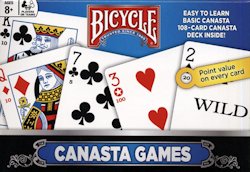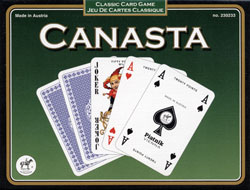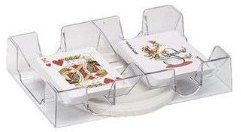Samba
This page is based on a contribution from Harrie Wiering, who describes the Dutch version of this game.
Samba is Canasta variation. In some places it is known as Samba-Canasta; one Dutch book also calls it Straat-Canasta (Sequence-Canasta). It is recommended that you understand the basics of Canasta before you play this variation.
|
Piatnik or Bicycle Canasta cards (marked with point values) can also be used for Samba. They come as a double pack (108 cards) so you would need two of these for a three-deck samba game. These canasta cards can be ordered from amazon.com. A range of Card Trays is also available. |
Players
Samba is a three pack card game that can be played with 2, 3, 4, 5 or even 6 players! When you're playing with two, three or five players, everyone plays his or her own game; when you're playing with 4 or 6 players, you play with a partner. When there are four players you and your partners are placed opposite at the table. In the event of 6 players, all partners are always separated by two other players.
Cards
Samba is played with 162 cards, three decks of 52 cards and 6 jokers. The values of the individual cards are as follows:
Ace 20 points King, Queen, Jack, 10, 9, 8 10 points 7, 6, 5, 4 5 points black 3 5 points red 3 see below 2 (wild) 20 points joker (wild) 50 points
The twos and jokers are wild cards. The 4s to aces inclusive are natural cards. The threes have special uses, described later.
Deal
When there are 2, 3, 4, or 5 players, 15 cards are dealt to each player. When there are 6 players, everyone receives 13 cards.
The next card is placed face up on the table to start the discard pile, and the remaining cards are stacked face down beside it, to form the stock.
Melds
The objective of the game is to score points for melds, which are sets of cards which you display face up on the table. In partnership versions of the game, melds belong to a partnership, not an individual. If you begin a meld, you partner can later add cards to it, and vice versa. The value of a meld is the sum of the values of the individual cards in it.
There are two types of meld: groups and sequences. A group of seven or more equal cards is a canasta, and a sequence of seven cards is caled a samba. To end the game by going out, your team must have melded at least two sambas or two canastas or one of each.
Groups and Canastas
A group is a set of three or more natural cards of the same rank, for example three kings, or five eights. Wild cards can be used to substitute for some of the cards of a group, with the following restrictions:
- there must be at least twice as many natural cards as wild cards;
- there must not be more than two wild cards in a group.
A group of seven or more cards is called a canasta. If all the cards in it are natural, it is a pure canasta, indicated by stacking the cards together with a red card on top. If it contains one or more wild cards, it is a mixed canasta, indicated by stacking the cards with a black card on top.
Further cards, beyond seven, can be added to a canasta, but if you add wild cards to a pure canasta, this degrades it to a mixed canasta.
It is also possible to meld a group, or even a canasta of black threes, but black threes can only be melded on the turn in which the player who melds them goes out.
In Samba, it is legal to have more than one group of the same rank of cards and keep them separate. So if I have melded two aces and a joker, I can later start a separate meld consisting entirely of real aces, hoping to make a pure canasta.
Sequences and Sambas
The novelty in this game, compared to Canasta, is the fact that you can build sequences. A sequence is a set of at least three natural cards of the same suit which are consecutive in rank. Sequences can be extended to a maximum of seven cards; a complete sequence of seven cards is called a samba. No further cards can be added to a samba.
Wild cards and threes cannot be used in a samba. Therefore only five different sambas are possible in a suit, consisting of the ranks: 4-10; 5-jack; 6-queen; 7-king; 8-ace.
Red Threes
You may meld a red three as a single card, to be eligible for a bonus, but you don't have to. Every melded red three is worth 100 bonus points, but only when you have the required two sambas or canastas necessary to end the game. When you are lucky enough to have melded all 6 red threes (or you and your partner together in a 4 or 6 game) you receive a bonus of 1000 points instead of 600 points.
If you do not have the necessary sambas or canastas to end the game, for every melded red three you receive 100 penalty points.
If the round is finished and you have one or more red threes in your hand, you will be penalized with 750 points, regardless of the number of red threes that you hold.
You may also use the red threes to block the discard pile, in the same manner as you would do with the black threes or the wild cards.
Black Threes
These can be melded in groups (following the normal rules for groups), but only on the turn on which you go out. They also block the discard pile for the opponents when discarded.
Play
The play begins with the player to dealer's left and continues clockwise. A turn normally consists of:
- drawing two cards from the stock;
- melding some cards from your hand if you wish to;
- discarding one card.
If your team has not yet melded, then the first time that you meld, the value of the cards that you meld must be at least the minimum value shown in the following table. The minimum depends on your team's score to date:
Score Minumum Initial Meld
0 to 1495 points 50 points
1500 to 2995 points 90 points
3000 to 6995 points 120 points
7000 points or more 150 points
negative score 15 points
Scores for red threes and bonuses for a samba or canasta do not count towards meeting the minimum meld.
Instead of drawing two cards from the stock, you may draw from the discard pile in two situations:
- if you have in your hand two natural cards which match the top card of the discard pile in rank, you may take the pile, provided that you first meld the top card together with the two cards from your hand. If you have not yet melded, you can only take the pile if you meet the initial meld requirements using the top card of the discard pile plus cards from your hand. The procedure is:
- take the top card from the discard pile;
- meld this card together with the two matching cards from your hand;
- if this is your first meld, meld further cards from your hand so as to meet the minimum requirement;
- take whole of the rest of the discard pile;
- make any further melds you wish;
- discard one card.
- if you already have on table a sequence meld of less than seven cards, and the top card of the discard pile fits on one end of the sequence, you may take this one card only from the discard pile and add it to your sequence, instead of drawing two cards.
It follows from the above, that it is impossible to take the pile or its top card when the top card is a three (red or black), a two or a joker. Discarding one of these cards therefore in effect blocks the next player from taking the pile.
Canasta players should note that in this game there is no concept of freezing the discard pile. In fact, the pile is effectively frozen all the time. You may never take the pile to add the top card to an existing group, unless you can produce two more natural cards of that rank from your hand.
Also note that you cannot take the pile or its top card to make a new sequence meld. The top card can only be taken if it fits onto the end of a sequence that is already on the table. For example:
- if I have
 6-
6- 7-
7- 8-
8- 9 melded and
9 melded and  10 is discarded by the player before me, I can take the discard;
10 is discarded by the player before me, I can take the discard;
- if I have
 6-
6- 7-
7- 8-
8- 9 in my hand and
9 in my hand and  10 is discarded by the player before me, I cannot take the discard;
10 is discarded by the player before me, I cannot take the discard;
- if I have
 6-
6- 7-
7- 8 melded and
8 melded and  9 in my hand
9 in my hand  10 is discarded by the player before me, I cannot take the discard.
10 is discarded by the player before me, I cannot take the discard.
Two sequences of three cards already on the table cannot be merged into a samba when you meld the connecting card. However, you are allowed to merge two group melds of the same rank on your turn if you wish.
Going Out
When a player goes out, by playing so as to have no cards left in their hand, the play ends and the hand is scored. You may go out either by melding all your cards or by melding all but one and discarding the last one. However, you are only allowed to go out if your team has melded two sambas, or two canastas (pure or mixed ones), or one samba and one canasta.
If you do not yet have the required sambas or canastas, you must play in such a way as to retain at least one card in your hand. This means that you are not allowed to meld all the cards in your hand. If you meld all your cards except one, then instead of discarding it you must end your turn by saying pass, and keep the card. This is the only case in which you are allowed to pass instead of discarding.
If you are able to go out, you may if you wish first ask your partner for permission to end the game, by saying "partner, may I go out?". Partner says "yes" or "no" and you must abide by the answer. Alternatively, you are allowed to go out without consulting your partner.
If no one goes out, eventually the stock will run out of cards. If there is just one card left in the stock, the next player who draws from the stock takes just that one card rather than the usual two, and completes his turn, melding and discarding in the usual way. When the stock is empty, play continues until the next time someone wants to draw cards from the stock (this will generally be at the beginning of the next player's turn, unless that player prefers to take the discard pile). As soon as a player wishes to draw from the stock but no cards are available, the play ends and the hand is scored, with no one getting the bonus for going out.
Scoring
When a player goes out, each team scores plus the total value of the individual cards it has melded, minus the value of the cards left in their hands, plus any of the following bonuses that apply:
- any special bonuses or penalties for red threes;
- each samba is worth 1500 bonus points;
- each pure canasta (without wild cards) is worth 500 bonus points;
- each mixed canasta (with a maximum of two wild cards ) is worth 300 bonus points;
- the side that goes out scores 200 bonus points.
The object of the game is to reach a score of 10,000 points. The first team that reaches or exceeds this score at the end of a hand wins the game. If more than one team reaches this score at the same time, the team with the shighest score wins.
Strategy hints
It is wise to keep in mind that every samba always contains an 8, 9 or 10. If you're trying to reach a samba of spades for example, and a player has a canasta with 2 eights, nines or tens of spades, the chance that you will succeed in forming a samba is small. Perhaps you would do better to rearrange your hand to form true canastas.
When you have a sequence consisting of 8, 9, and 10, it is wise to meld them. Your partner may have the missing cards.
Remember, red threes are only bonus points when you have the two required sets to go out.
In samba wild cards are not so important as in canasta. Since they also block the discard pile, you may use them to stop the opponents obtaining the discard pile, especially if the discard pile contains cards you need to form your own samba(s).
At the start of your turn you take 2 cards of the stock. You discard only 1 card! Thus the number of cards in you hand thus grows steadily. Some players make separate piles of their black threes, twos and jokers to avoid cramp.
Other Samba web pages and Variations
Another description can be found on the Samba page of Randy Rasa's Rummy-Games.com web site.
Bolivia is a game similar to Samba, but allowing melds consisting entirely of wild cards. A meld of 7 wild cards (twos and/or jokers) is called a bolivia and is normally worth 2500 points. To go out, two 7-card melds are needed, of which at least one must be a sequence meld (escalera).
In his book The Canasta Collection, David Mallen has published rules for Sambola, a variant incorporating features of the New Zealand Canasta variant Jonola - and Black Samba, a variant in which a wild card can be used in a sequence meld, as well as simplified rules for Bolivia and Samba.
Peter Jakeman, Canasta Advisor of U3A (UK) has published rules for Trey, a form of Bolivia that can be played by 4 players using 3 decks, and Quad, a 6-player version using 4 decks (Microsoft Word documents).
Antonin Jaun's German language site canasta.ch (archive copy) has rules and information for Samba and Bolivia and their variants.
Ronald Magazzu's book Royal Canasta describes a three-pack Bolivia variation incorporating melds of red and black threes ("Royal Canastas").


